



Furniture Fiesta Life & Culture
LIFE AND CULTURE SHOPPING TRENDS HOME TOURS DESIGN DECORATING
.jpg)
Regular sofa cleaning is essential to maintain its appearance and prolong its lifespan
Sofas are among the most utilized furniture items in any household. Whether unwinding after a long workday or enjoying a tranquil weekend with loved ones, your living room sofa consistently provides comfort and support.
The sofa holds a prominent position as the first impression for visitors. Your home reflects your personality, and a poorly maintained or mismatched couch can impact how others perceive you. Therefore, understanding how to clean a sofa at home is crucial for maintaining hygiene and a positive image.
Many people invest in expensive sofas for their utility and aesthetic appeal. However, over time, every sofa experiences wear and tear. Dust, food spills, body oils, pet fur, and other stains can mar its quality and appearance. Beyond aesthetics, an unclean sofa poses hygiene and safety risks.
Due to these concerns and the lack of knowledge on how to clean a fabric couch at home, people often opt for dark-colored sofas in durable fabrics that are easier to maintain. Yet, if these choices don't align with the interior design, they can detract from the room's welcoming atmosphere. However, maintenance challenges should not discourage anyone from selecting a sofa they love.
Understanding how to remove stains from sofa at home and how to clean white fabric sofa at home are essential skills for sofa owners. Regular cleaning, including knowing how to wash sofa cushions, ensures your sofa remains fresh and appealing.
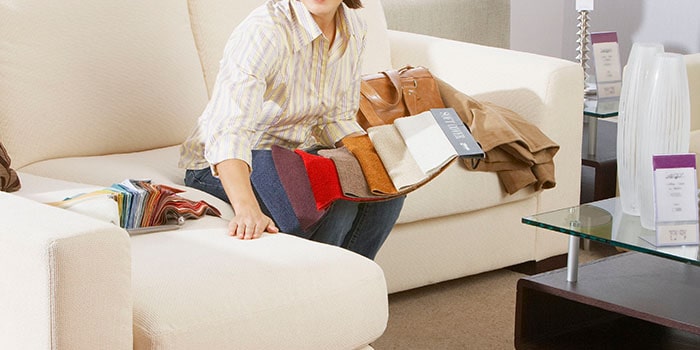
Regularly cleaning your sofa sets is crucial for maintaining their longevity and pristine appearance. Cleaning a fabric sofa helps preserve its original look and vibrant colors over time. It also eliminates unpleasant odors, dampness, and stains that can accumulate, especially if you have pets whose hair and dirty paws can introduce grime. These contaminants not only soil the sofa but can also potentially affect the health of your family members, particularly children.
Moreover, cleaning sofa at home infuses your living room with a fresh fragrance, creating a more inviting environment. It's important to address old stains promptly through sofa washing and shampooing to ensure a clean and hygienic seating area. Unclean sofas tend to emit unpleasant odors that can permeate the room, detracting from its ambiance.
For effective cleaning, consider using natural fabric sofa cleaners commonly found in your kitchen. These methods not only sanitize the sofa but also contribute positively to the overall atmosphere of your home. Additionally, proper care extends to leather sofas, and specific tips on how to clean leather sofa sets can help maintain hygiene standards throughout your living space.
Regularly cleaning fabric sofa at home not only enhances its longevity but also preserves its colors and quality. By eliminating germs and bacteria, you can create a fresh and inviting indoor environment. Proper maintenance ensures that your sofa lasts longer than expected. To maintain hygiene and extend the life of your furniture, follow these tips on how to clean fabric couch, how to remove stains from sofa at home, and how to clean white fabric sofa at home. Additionally, learn how to wash sofa cushions effectively to keep your furniture looking and smelling its best.
Proper upkeep, regular maintenance, and simple tricks can shield your sofa from significant wear and tear, significantly extending its lifespan and ensuring maximum value for your investment. Learning how to clean a fabric couch at home and performing DIY sofa cleaning rather than hiring professionals can also keep your budget in check.
In this article, we cover everything you need to know about how to clean a fabric couch at home, effective methods for removing stains from sofa, particularly how to clean a white fabric sofa at home, as well as tips on cleaning sofa cushions and performing home dry cleaning for sofas. These steps will help you maintain your fabric couch's appearance and durability for years to come.
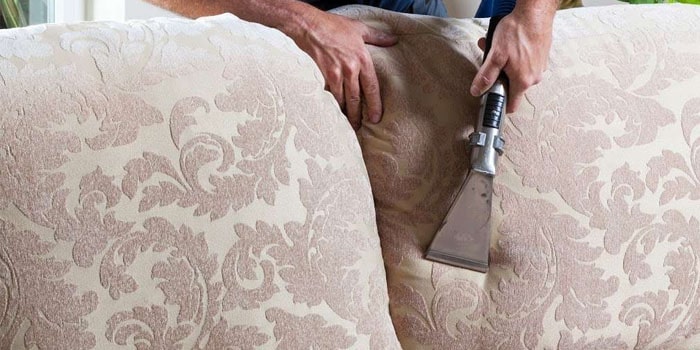
Each sofa is unique in its construction, varying in shape, material, fabric, and cut, which directly impacts its cleaning requirements. There is no universal method for cleaning sofas at home that fits all types.
For example, cleaning our Single Seater Lounger and Amoeba Sofa Cum Bed demands different approaches based on the chosen fabric or linen. Therefore, the first crucial step is to thoroughly understand the specific cleaning needs of your sofa.
To achieve optimal results, follow this essential pre-cleaning checklist:
Sofas are available in a diverse range of fabrics, including leather, velvet, linen, cotton, polyester, and various blends. Some sofas combine two or three materials, each with unique care requirements. Therefore, identifying the fabric used in your sofa is crucial. Typically, this information can be found on tags and invoices.
Leather: Easily cleaned with a damp cloth; excessive water should be avoided to prevent damage.
Velvet: Prone to attracting lint and dust; gentle detergents are recommended for cleaning.
Cotton: Low-maintenance but may shrink if washed; initial dry cleaning is advisable.
Additionally, check if any parts of the sofa are detachable, as many sofas feature removable covers that simplify cleaning. When purchasing a new sofa, consider your specific needs and consult the manufacturer regarding home cleaning methods. Fabrics like velvet or light-colored materials may require more delicate care than others.
For tips on how to clean fabric couches effectively, remove stains from sofas at home, clean white fabric sofas, wash sofa cushions, or remove stains from couches, it's essential to follow manufacturer guidelines and use appropriate cleaning methods to maintain your sofa's appearance and longevity.
To effectively clean a fabric couch at home, start by following these essential steps to eliminate the initial layer of dust and dirt.
Ensure thorough cleaning by paying attention to all corners and hidden spots. If your vacuum cleaner includes attachments like fabric brushes, utilize them for optimal results. However, a standard vacuum cleaner is equally effective.
Dust Off the Sofa While vacuuming removes surface dust, follow up by wiping down the sofa with a damp cloth to achieve a polished look. This step is suitable for fabrics that can withstand damp cleaning, such as leather sofas. Fabrics like suede and velvet require alternative cleaning methods.
Tackle Lint Build-Up Lint, those tiny fabric particles that accumulate over time, cannot be effectively removed by vacuum cleaners. To restore the sofa's smooth finish, use a lint roller across all fabric types. This versatile tool is suitable for various fabric materials.
Consider Steam Cleaning For a deeper cleanse, consider using a steam cleaner to release embedded dirt and achieve a cleaner sofa. While not mandatory, steam cleaning can be beneficial if you have the equipment available.
Follow these steps regularly—ideally every two weeks to a month—depending on your usage, to maintain a clean and fresh sofa.
Ensure your fabric couch remains in top condition with these practical cleaning tips, including how to clean white fabric sofa at home and how to wash sofa cushions effectively. Regular maintenance is key to preserving the longevity and appearance of your furniture.
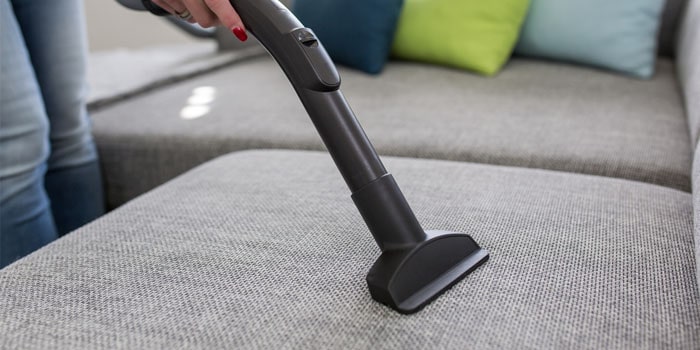
Sofa deep cleaning has various aspects to it. Deep cleaning is an extensive process, and you can do this every six months to maintain the quality of your sofa. If done regularly, this process will not take a lot of time.
Stains pose a significant challenge when it comes to learning how to clean a fabric sofa at home. Sofa stains are notorious for detracting from its appeal. Even a minor stain can mar the sofa's appearance. Here's a guide on effectively managing sofa stains:
Act Quickly
Quick action is crucial when dealing with stains. The longer a stain sits, the tougher it becomes to remove. Act promptly to prevent it from setting in.
Begin by gently blotting the stained area with a cloth, regardless of whether it's caused by food, paint, mud, or other substances. Be careful not to spread the stain to unaffected parts of the sofa.
Choose the Right Approach
Spilling something on your sofa can induce panic, leading to hasty actions that may worsen the situation.
Maintain composure and select an appropriate cleaner based on the fabric type. If your sofa's fabric is labeled with an S, avoid water-based cleaners and opt for rubbing alcohol instead. For fabrics labeled with W, water-based detergents are suitable for spot cleaning.
Detergent pens are also effective, especially for delicate fabrics. Additionally, periodic sofa shampooing helps maintain cleanliness.
Tackling Stubborn Stains
While food stains are relatively manageable, other stains can be more challenging. Proper sofa cleaning techniques can effectively remove various types of stains.
Implement these methods to learn how to clean a fabric couch, remove stains from a sofa at home, and maintain a white fabric sofa's pristine appearance. Understanding how to wash sofa cushions and handle tough stains ensures your sofa stays in top condition.
When it comes to maintaining sofas, there are various types of materials used, with leather being one of the most stylish choices. Learning how to clean leather sofas is essential to preserve their elegance and durability. Here are some effective tips for leather sofa care:
Avoid Moisture: Moisture is detrimental to leather, potentially causing damage.
Protect from Sunlight: Keep leather sofas away from direct sunlight to prevent color fading. Rotate cushions and pillows regularly if your living room receives ample sunlight.
Use Homemade Solutions: For immediate care, consider using a DIY solution with white vinegar and olive oil. This helps protect against discoloration and is effective for cleaning sofa cushions at home.
Damp Cloth for Dusting: Always use a damp or dry cloth to wipe dust from the sofa. Avoid leaving leather moist, as it can foster mold and mildew growth.
Vacuum Regularly: Vacuuming is a quick way to clean leather sofas. Use a vacuum with low heat to prevent fabric damage.
For fabric sofas, cleaning and maintaining them require different strategies. Learn how to clean fabric couches, remove stains from sofas at home, clean white fabric sofas effectively, and wash sofa cushions with these expert tips.
By following these practical suggestions, you can keep your leather and fabric sofas looking pristine and extend their lifespan. For more detailed guidance on how to clean fabric couches and handle specific stains, consult our comprehensive sofa care guide.
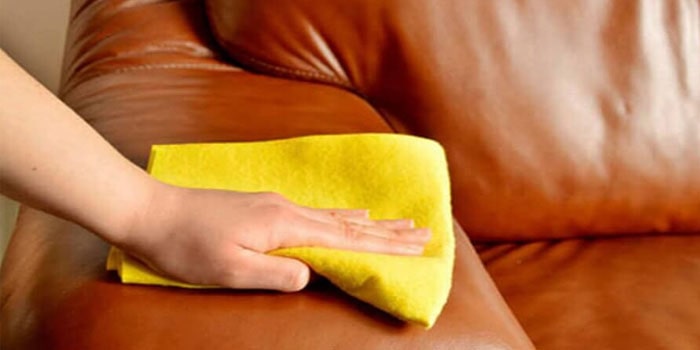
Disinfection is a straightforward process, unlike cleaning. It involves eliminating germs and bacteria from surfaces, even those invisible to the naked eye, which can pose health risks.
When sanitizing your sofa, opt for a hand or laundry sanitizer or a natural disinfectant spray. These options are generally gentle and won't harm the fabric. To be safe, test the disinfectant on a small corner of the sofa and observe for any adverse reactions before proceeding.
Here's a quick guide to effectively disinfect and clean your sofa:
Regular pest control measures are essential to complement sanitization efforts and ensure a clean and safe environment for your family.
Cleaning and sanitizing your sofa protects against harmful germs and viruses. Both alcohol-based and natural disinfectants are effective for maintaining fabric sofas, offering easy maintenance. For those wondering how to clean a fabric couch without water, consider using baking soda, a gentle yet effective option that preserves the sofa's material integrity.
For more tips on how to clean fabric couches or remove stains from sofas at home, consult with professional cleaning services for tailored solutions to keep your furniture pristine and germ-free.
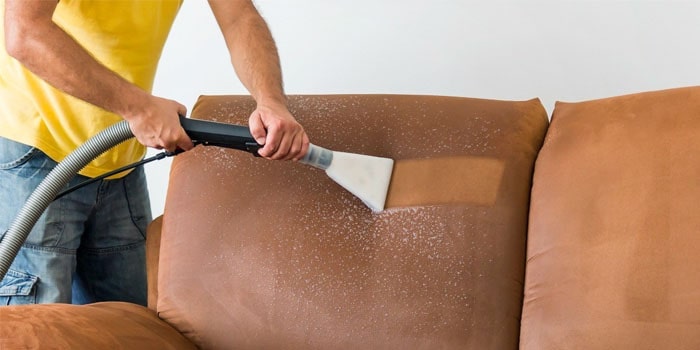
If you're looking to maintain your fabric couch without using water, consider using baking soda, which possesses gentle yet effective cleaning properties. It effectively removes stains, dirt, and unpleasant odors without damaging the material.
Here’s a step-by-step guide on how to dry clean your sofa at home:
To start, thoroughly vacuum your sofa using a specialized vacuum cleaner for sofa and bed to eliminate any surface dirt or dust.
Next, evenly sprinkle a fine layer of baking soda over your couch.
Using a soft brush, gently scrub the sofa's surface until the stains are lifted.
Allow the baking soda to sit for about an hour to absorb odors and further loosen stains.
Finally, vacuum the entire sofa to remove the baking soda residue, leaving behind a pristine and fresh-smelling couch.
This method ensures effective cleaning and odor removal while preserving the fabric of your couch. For more tips on how to clean a fabric couch or remove stains from a sofa at home, visit our website for comprehensive guides and expert advice.
Vacuum Thoroughly: Use a soft brush attachment to remove loose dirt and debris.
Prepare Cleaning Solution: Mix mild detergent or liquid soap with lukewarm water.
Blot Stains: Dampen a microfiber cloth with the solution and gently blot stains; avoid rubbing.
Use Vinegar for Tough Stains: Add a bit of white vinegar to the solution for stubborn stains.
Rinse and Blot: Rinse cloth with clean water and blot to remove soap residue.
Air Dry: Allow the sofa to air dry completely; avoid direct sunlight.
Regular Maintenance: Vacuum weekly and promptly spot clean spills to prevent stains.
To effectively remove stains from your couch, start by identifying the type of stain you're dealing with, such as food, drink, or grease. Immediately blot up any excess liquid using a clean cloth or paper towel. Choose a suitable cleaning solution based on the fabric: mild detergent diluted in water, white vinegar mixed with water, or an upholstery cleaner. Test the chosen solution on a hidden area of the couch first to ensure compatibility. Apply the solution to the stain using a clean cloth, blotting or gently rubbing in a circular motion. Rinse the cloth with clean water and continue blotting until the stain is lifted. Once clean, blot the area dry with a dry cloth and allow it to air dry completely before using the couch again.